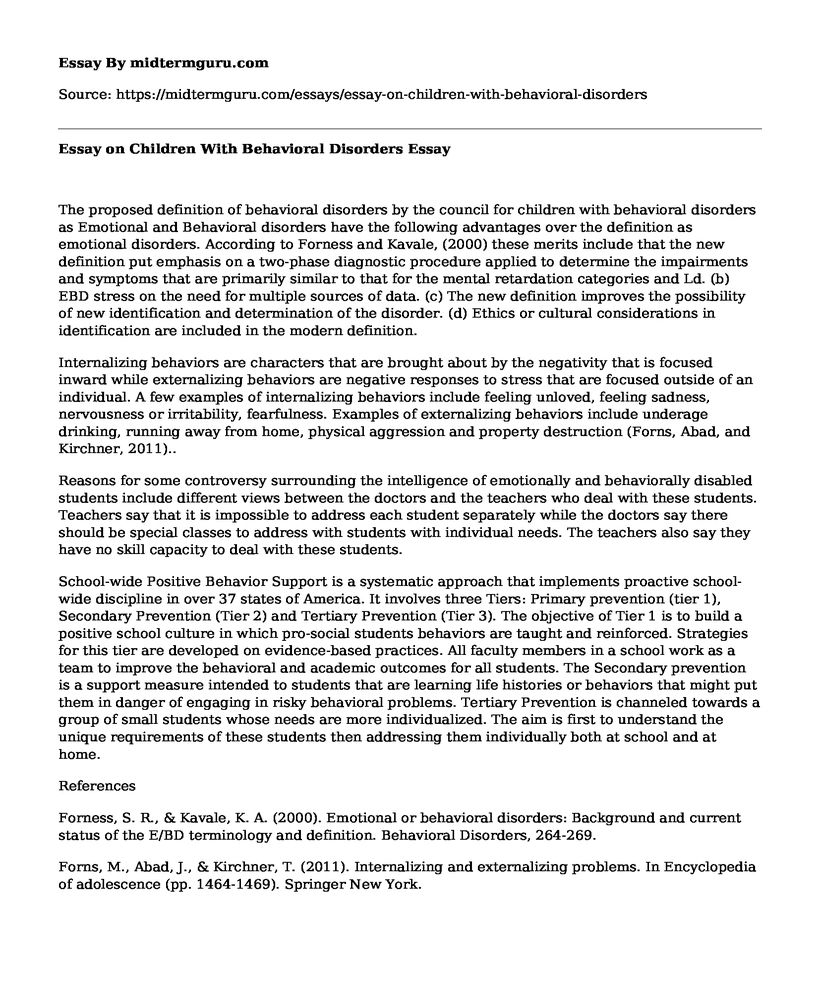The proposed definition of behavioral disorders by the council for children with behavioral disorders as Emotional and Behavioral disorders have the following advantages over the definition as emotional disorders. According to Forness and Kavale, (2000) these merits include that the new definition put emphasis on a two-phase diagnostic procedure applied to determine the impairments and symptoms that are primarily similar to that for the mental retardation categories and Ld. (b) EBD stress on the need for multiple sources of data. (c) The new definition improves the possibility of new identification and determination of the disorder. (d) Ethics or cultural considerations in identification are included in the modern definition.
Internalizing behaviors are characters that are brought about by the negativity that is focused inward while externalizing behaviors are negative responses to stress that are focused outside of an individual. A few examples of internalizing behaviors include feeling unloved, feeling sadness, nervousness or irritability, fearfulness. Examples of externalizing behaviors include underage drinking, running away from home, physical aggression and property destruction (Forns, Abad, and Kirchner, 2011)..
Reasons for some controversy surrounding the intelligence of emotionally and behaviorally disabled students include different views between the doctors and the teachers who deal with these students. Teachers say that it is impossible to address each student separately while the doctors say there should be special classes to address with students with individual needs. The teachers also say they have no skill capacity to deal with these students.
School-wide Positive Behavior Support is a systematic approach that implements proactive school-wide discipline in over 37 states of America. It involves three Tiers: Primary prevention (tier 1), Secondary Prevention (Tier 2) and Tertiary Prevention (Tier 3). The objective of Tier 1 is to build a positive school culture in which pro-social students behaviors are taught and reinforced. Strategies for this tier are developed on evidence-based practices. All faculty members in a school work as a team to improve the behavioral and academic outcomes for all students. The Secondary prevention is a support measure intended to students that are learning life histories or behaviors that might put them in danger of engaging in risky behavioral problems. Tertiary Prevention is channeled towards a group of small students whose needs are more individualized. The aim is first to understand the unique requirements of these students then addressing them individually both at school and at home.
References
Forness, S. R., & Kavale, K. A. (2000). Emotional or behavioral disorders: Background and current status of the E/BD terminology and definition. Behavioral Disorders, 264-269.
Forns, M., Abad, J., & Kirchner, T. (2011). Internalizing and externalizing problems. In Encyclopedia of adolescence (pp. 1464-1469). Springer New York.
Cite this page
Essay on Children With Behavioral Disorders. (2021, Jun 03). Retrieved from https://midtermguru.com/essays/essay-on-children-with-behavioral-disorders
If you are the original author of this essay and no longer wish to have it published on the midtermguru.com website, please click below to request its removal:
- Essay Sample on Contemporary Body Image
- Why People Abuse Drugs and Effects to Their Mental Well-Being - Paper Example
- Depression in College Students: Annotated Bibliography
- How Physical Aging Can Affect One's Quality of Life - Essay Sample
- Technology and Mental Health: How Screen Use Affects Kids - Essay Sample
- Understanding Human Behavior and Its Relationship to Family Bonds - Essay Sample
- Epidemiology of PTSD: Prevalence Across Countries - Research Paper







